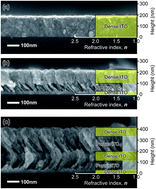Enhanced phosphor conversion efficiency of GaN-based white light-emitting diodes having dichroic-filtering contacts†
Abstract
White light-emitting diodes (LEDs) based on the combination of a GaN-based blue LED chip and a yellow phosphor layer suffer from a low phosphor conversion efficiency (PCE) because a significant amount of the yellow fluorescence is emitted towards the blue LED chip where the fluorescence is partially absorbed. In this study, we greatly enhanced the PCE of a white LED by embedding a dichroic-filtering contact (DFC) which multi-functioned as a blue-transmitting but yellow-reflecting optical filter as well as a low-resistance ohmic contact to p-type GaN. Electrically conductive DFCs consisting of alternating layers of dense and nanoporous indium-tin-


 Please wait while we load your content...
Please wait while we load your content...